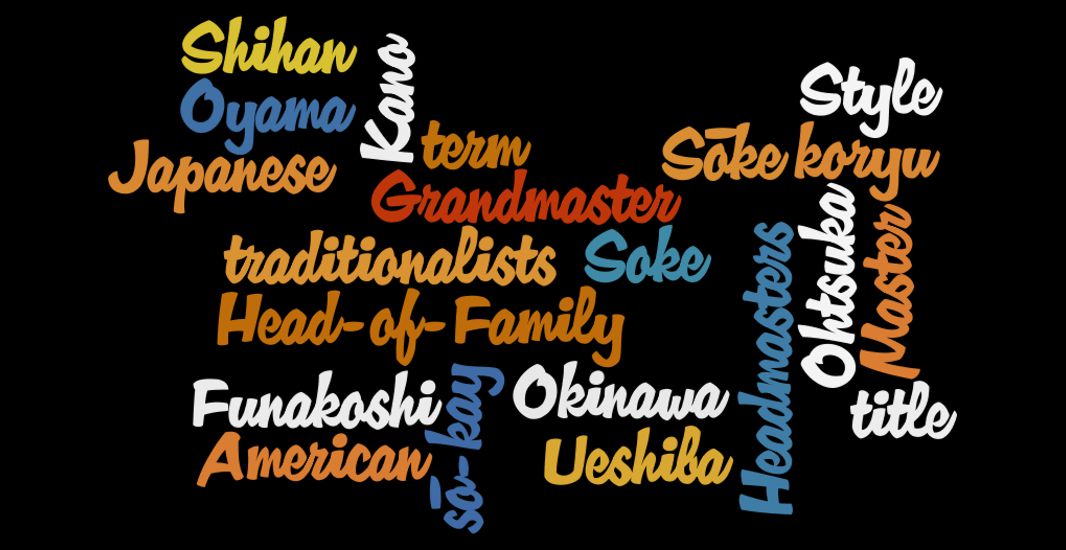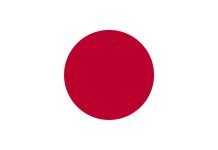The so-called controversy and dilemma with the use of the term sōke in martial arts has only been seen in a few articles (self-published) and on a few martial arts on-line forums. Those few individuals seem to rant and rave, spouting mostly opinion, inaccurate “facts”, as well as merely proffer attacks against styles, martial artists and sōke organizations. We address the fallacious arguments and separate the facts from the opinions right here in, “It’s Sōke. It’s alright.”
Soke – its definition.
Soke (pronounced sō-kay) is a Japanese title and term meaning and often used to indicate “headmaster” or “head of the family”. Some trace the terms usage back to China and the title Tsung Chia, “master of the house” (sōke in Japanese). It is generally accepted to mean, one who is the leader of any school or the master of a Ryu (style), but is most commonly used as the highest level Japanese title, referring to the singular leader of a school or style of martial art. The term was and is not limited to the genre of martial arts. Sōke are generally considered the ultimate authority within their art and have final discretion and authority regarding curriculum, doctrine, philosophy, disciplinary actions and promotions. A sōke has the authority to issue a menkyo kaiden certificate indicating that someone has mastered all aspects of their style. While the English translation of sōke as “grandmaster” is not a literal translation, it does see use by some Japanese sources. Soke does not mean “grandmaster” or ‘founder”. The first generation sōke/headmasters of their art are “shodai sōke” and are thus both sōke and founder. The terms use or lack thereof is completely style or organization specific.
Sōke, a dated term/title no longer used by Japanese?
Some modern “traditionalists’ use the Japanese Meiji restoration (1868) as the cut-off date for any martial artists using the term sōke. They argue that if the art was not founded before the Meiji restoration, the term sōke should not be used. They argue that if the martial is not a or of “koryu” (“old” or “ancient stream”) the term should not be used. Another argument proffered by modern “traditionalists” is that “even the Japanese don’t use the term/title sōke. However, there are many Japanese Gendai Budo (modern martial arts founded in Japan) that use the term sōke such as: Go-soku by Takayuki Kubota, Sōke; Heiwa-do by Kiyohisa Hirano, Sōke; Isshinryu Karate by Tatsuo Shimabuku, Sōke; Hayashi-Ha Shito-Ryu by Teruo Hayashi, Sōke; Takamatsu Toshitsugu, Sōke; Fumon Tanaka, Sōke; Shogu Kuniba, Sōke; and Hatsumi Masaaki, Sōke. End of argument #1.
Sōke term/title limited to Japanese?
Some modern “traditionalists’ argue that sōke is a “Japanese” term and should only be used by those that are Japanese. This is completely unreasonable, as well as ridiculous because:
(1) modern western martial artists are, and have for decades been referred to as Sensei and Shihan and been readily accepted by the Japanese martial arts community; and,
(2) many of those making these arguments actually use the Japanese terms/titles Sensei or Shihan (if they have earned it and it is used in their particular martial arts style). To not use the term/title simply because one is not Japanese is simply absurd. End of argument #2.
Sōke term/title only for arts founded in Japan and/or by Japanese?
Again, some modern “traditionalists” argue that the term/title sōke is only appropriate for martial arts founded in Japan or Okinawa and/or by someone that is Japanese. An example of a modern martial art created by a non-Asian in the United States and recognized by both Japan and Okinawa is Dr. Mike Sadler and his Shingo Ryu Bujitsu Kai (now Shingo-ha Yoshukai) martial art which was formally recognized and registered as a legitimate martial art style by the International Okinawan Martial Arts Union of Okinawa and Japan and awarded the title, Sōke in 1995 (sponsored by Master Suzuki (of the Dai-Nippon Seibukan of Japan and Shian Toma (of Seidokan Motobu-Ryu of Okinawa). Additionally we find Kiyohisa Hirano, Sōke born in Yokohama, Japan founded Japan International Karate-Ki Center (JIKC) and his style, Heiwa-do in 1962 in Hawaii (which incorporates a significant portion of Shotokan, while also infusing elements of Shito-ryu karate and Goju-ryu Karate). Also, there is the late Oyama Masutatsu/Mas Oyama, who was born and raised in Korea until the age of 15 and went on to become the Founder of Kyokushinkai while living in Japan. There we have: a non-Asian martial artist creating a modern martial art recognized by Japanese and Okinawan martial arts organizations; a Japanese-national creating a martial art in the United States; and a Korean-national creating a martial art in Japan.
End of argument #3.
Sōke, anything but Sōke?
Again, modern “traditionalists” argue that many other Japanese terms/titles are permissible such as: So Shihan (Head Master); Shuseki Shihan (Chief/Head Master); Shuryou Shihan (Chief/Head Master); Saiko Shihan (Oldest Master); Shihan Ke/Shihanke (Master of the Family); Kancho (Head of House/Ownership); Kaicho/Kai Cho (Head of Group or Organization); and O’Sensei (Senior/Elder/Superior Teacher). However, the term/title Sōke is apparently for some reason the “forbidden fruit” of Japanese terms/titles. This is simply ridiculous. If any of these Japanese terms/titles are permissible, then all of them are permissible, including Sōke. End of argument #4.
Sōke, it has to be inherited?
Some people argue that for someone to be a ‘true” sōke, they have to have inherited the title or be recognized as a sōke by another “true” sōke. This argument is both fallacious and circular. By it’s very definition a sōke is the “headmaster”/“head of the family” referring to the singular leader of a school or style of martial and considered as the ultimate authority within their art and have final discretion and authority regarding curriculum, doctrine, philosophy, disciplinary action and promotions. The first generation sōke/headmasters of their art are “shodai sōke” and are thus both sōke and founder. When someone “founds” an art it cannot by its’ very nature be inherited. Also to require another sōke to recognize another as a sōke of a different martial art creates a “closed universe” situation resulting in the possibility of only one martial art (which came first, the chicken or the egg).
While a sōke title can be inherited, it does not have to be as in the case of a Shodai Sōke. If a Shodai Sōke is recognized by other Sōke as a Sōke even better, but it’s not required.
End of argument #5.
History of young Japanese “founders” combining martial arts and incorporating gi’s, obi’s and a kyu/dan system.
After trade relationships were established with the Ming dynasty of China by King Satto of Chūzan in 1372, some forms of Chinese martial arts were introduced to the Ryukyu Islands by visitors from China, particularly Fujian Province. However, by 1609 there was a political policy of banning weapons enforced in Okinawa which further influenced the development of unarmed combat techniques. There were few formal styles of te/ti, but rather many practitioners with their own methods. Early karate styles are generalized as Shuri-te, Naha-te and Tomari-te, named after the three cities from which they emerged. Each city and its teachers used particular kata, techniques, and principles which distinguished their version of te/ti from others.
Sakukawa Kanga (1782-1838) began teaching a style called “Tudi-Sakukawa” (Sakukawa of Chinese Hand) in 1806. His most prominent student, Matsumura Sōkon (1809-1899) later taught a combination/synthesis of Shuri-te, Tomari-te and Shaolin styles that would later become the Shōrin-ryu style. One of his students, Ankō Itosu (1831-1915 and considered the Grandfather of Modern Karate) created the ping’an forms (heian and or pinan in Japanese) which became common across nearly all styles of karate. Itosu’s student, Gichin Funakoshi and founder of Shotokan Karate is generally credited with introducing and popularizing karate on the main islands of Japan. Funakoshi knew that the art of Tang/China hand would not be accepted in Japan because Japan was invading China at the time, thus the change of the arts name to karatedō (the way of the empty hand). Just like most of the arts practiced in Japan, karate made its transition from –jitsu to –dō around the beginning of the 20th century. The dō in karatedō sets it apart from karate-jutsu, just as aikido is distinguished from aikijutsu, judo from jujitsu, kendo from kenjitsu and iaido from iaijutsu. Funakoshi changed the names of many kata and the art itself, doing so to enable karate to be accepted by the Japanese budō organization Dai Nippon Butoku Kai.
The modernization and systematization of martial arts in Japan included the adoption of: the gi (uniform/kimono); the obi (belt); and the kyu/dan rank system of colored belts. Jigoro Kano, founder of Judo originated and popularized these innovations which was also adopted by Gichin Funakoshi and in turn adopted by many Okinawan and Japanese martial arts teachers.
The Japanese had established a pattern of training in a few martial arts from which they would derive, combine, synthesize and create a new martial art. Most, if not all did so while only in their 20’s. Some of these included: Funakoshi, who had trained in Okinawan Shorin-ryu and Shorei-ryu, but was also influenced by kendo’s ideas of distancing and timing before creating Judo; Jigoro Kano, who trained in Tenjin Shin’yō-ryu, Kitō-ryu and made vast innovations in jujitsu before synthesizing and creating Judo (Kano Jiu-Jitsu/Kano Jiu-do); Hironori Ohtsuka, who was a student of Funakoshi and also experimented with judo, kendo, aikido and jujitsu, and developed/synthesized his own style of karate, Wadō-ryu; Morihei Ueshiba, who trained in Daito-ryu Aikijitsu and Kenjitsu from which he derived and created Aikido; and, Masutatsu Oyama, who formed the new style of karate, Kyokushin, a combination/synthesis of Shotokan and Gōjū-ryu.
All of these men were creative and innovative leaders in creating/founding their respective martial art styles. All probably endured some criticism from their peers at the beginning of their arts. All were Sōke in their own right (by definition) regardless of whether or not they adopted or in any manner, utilized the term sōke. From these men and others like them, came the model of learning two or more martial arts from which to derive, combine , synthesize and form the creation of yet another martial art, most of which have some significant or partial influence or connection to the martial arts of old China, Okinawa or Japan.
Old Sōke, New Sōke on common ground.
There is much common ground between the Sōke of old and modern Sōke (be they Japanese, American or other). This common ground includes, but is not limited to the following:
- Both by simple definition are “Headmasters” – “Head of the Family” of their martial arts;
- Both trained in two or more martial arts before deriving, combining, synthesizing and creating their own martial arts style;
- Both were heavily influenced in the creation of their martial art by and have a connection to the original martial arts of Okinawa and Japan through principles, techniques, strategies, structures and philosophy;
- Both utilized Japanese terms in naming/describing their martial arts;
- Both were innovative, creative and courageous martial arts pioneers not merely content with following, but chose instead to lead; and,
- Both, through dedication, show respect, pay homage and emulate the qualities and characteristics of those that came before them.
*However, there is one important distinguishing fact between sōke of old and modern sōke, that being, modern sōke usually did not create their art until after 30 or more years of training and not until they were in their 40’s.
Sōke – modern usage of the term/title.
The modern usage of the term/title of sōke is by Japanese, American and others in regards to both inherited martial arts and new martial arts. However, the use of the term/title sōke seems to be most prevalently used as a “positional or administrative title” concerning a given art to accurately describe the arts’ “headmaster” – “head of the family”. Usually the sōke also has a “functional or hierarchical” title as well such as Shihan/Master/Grandmaster (insert first and/or last name), Sōke of (insert style name). Rarely is someone called Sōke (insert first and/or last name) or refer to themselves as Sōke (insert first and/or last name). The proper etiquette and protocol is generally to call the person by whatever title they may choose for their art. However, if it is a title so over-the-top and shocks your senses so much that you cannot even mouth the words, merely use another respectful but more palatable title such as Shihan, Master or Grandmaster.
The chef analogy.
Sōke of old and modern Sōke are like master chefs. Each create their own style of dishes and cooking utilizing: water and oils (strikes and blocks); grains (throws); spices (joint locks); with meat, fish and vegetables (forms, structure and philosophy). While neither created these ingredients (which have existed for eons), they were able to combine them in such a manner as to become notably stylistic. Not content with merely being just another cook, they were innovative, creative pioneers that instead chose the “road less traveled”, chose to lead, and became Master Chefs. Sōke, if you will, of their own style/brand of cooking. They first open a restaurant as the Master Chef and develop a following. They teach others their style/brand of cooking, who in turn open more restaurants increasing their following and exposure to the public. This continues until one of the Master Chef’s cooks after training for many years (also under other Master Chefs) create their own style of dishes and cooking sufficient to become notably stylistic, when they also chose the “road less traveled” and become a Master Chef , beginning a new cycle.
Conclusion.
Modern sōke (Japanese, American or other) will not and should not be summarily judged, ridiculed or dismissed by other “martial artists” merely due to their functional or administrative and appropriate (by definition) use of the term sōke in regards to their martial art. Those “brave and anonymous” martial arts forum “contributors”/bloggers time would be better spent furthering their training and honoring, respecting and actually practicing in the bushidō tradition, their dojo’s/styles’ kun (their guidelines for conduct in and outside their dojo) which in most cases dictates courtesy and respect to other styles and martial artists. The martial arts is a vast community where there is no place for petty insults or criticism.
Modern sōke, like those of old will be judged just as those that preceded them by: their years of training; their earned ranks; their personal skills and abilities; their character; the effectiveness of their arts curriculum, structure, and philosophy; what kind of martial artists, competitors and instructors they produce; and the legacy they leave behind (which for most is yet TBD – to be determined). In the mean time it should just be, “It’s Sōke. It’s Alright.”










